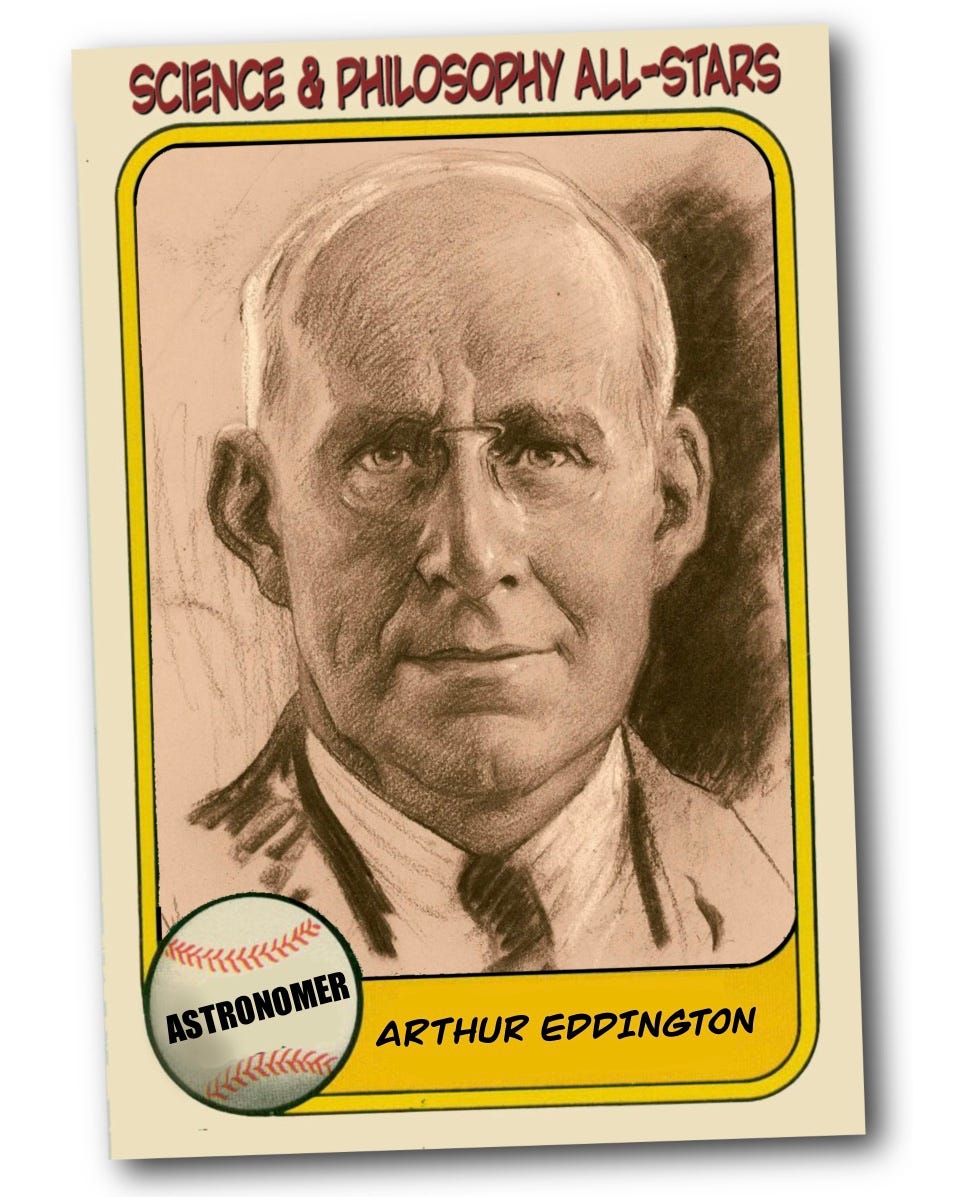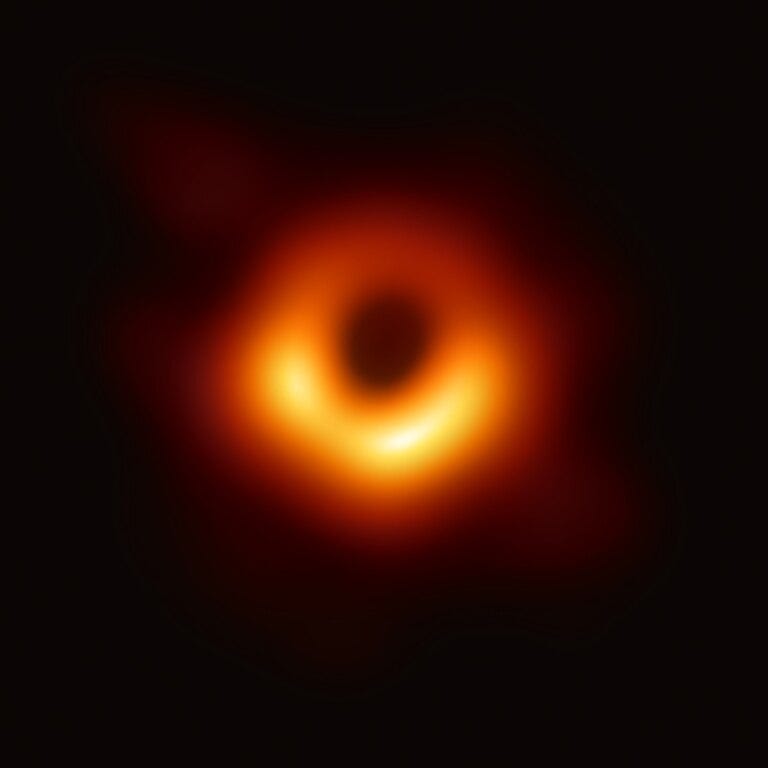Whether in the intellectual pursuits of science or in the mystical pursuits of the spirit, the light beckons ahead, and the purpose surging in our nature responds.
- Sir Arthur Stanley Eddington
After the worldwide news of the 1919 eclipse validating general relativity, a relatively obscure German physicist became a household name, and a British astronomer became the most recognized promoter of his ideas. Einstein himself said that Arthur Eddington’s 1923 book, The Mathematical Theory of Relativity, was “the finest presentation of the subject in any language.”
Following the successful eclipse mission in Principe, Eddington settled down at Cambridge, where he conducted blackboard expeditions into the interiors of distant stars, using Karl Schwarzschild’s model of hot gases held together by the opposing forces of gravity and heat. The young astronomer calculated the pressure and density of stellar cores and correctly concluded the temperatures must be in the millions of degrees, rather than in the thousands, as previously thought.
The 1930 publication of Eddington’s Internal Constitution of the Stars birthed the modern theory of stellar evolution.
“A star is drawing on some vast reservoir of energy by means unknown to us. This reservoir can scarcely be other than the sub-atomic energy which, it is known, exists abundantly in all matter; we sometimes dream that man will one day learn to release it and use it for his service. The store is well-nigh inexhaustible, if only it could be tapped,” he wrote, anticipating by two decades the Faustian discovery of nuclear fusion.
Eddington predicted that stars the size of our sun would end their days as “white dwarfs,” and predicted — accurately — that astronomers would find such a beast in the distant star Sirius B. He lyrically and amusingly described the physics of white dwarfs in 1927:
We learn about the stars by receiving and interpreting the messages which their light brings to us. The message of the Companion of Sirius when it was decoded ran: “I am composed of material 3,000 times denser than anything you have ever come across; a ton of my material would be a little nugget that you could put in a matchbox.” What reply can one make to such a message? The reply which most of us made in 1914 was — “Shut up. Don’t talk nonsense.”
Eddington’s books hold up surprisingly well to this day. His intellectual depth weave like a bass line through his writings, with humorous asides playing above the prose — as indicated by some doggerel from New Pathways in Science in 1938:
There once was a brainy baboon,
Who always breathed down a bassoon,
For he said, “It appears
That in billions of years
I shall certainly hit on a tune.”

A head in the stars but not ahead of his time?
On the less exalted side, Eddington’s bio is darkened by a legendary dispute with astronomer Subrahmanyan Chandrasekhar, then a student at Cambridge. The student had performed calculations indicating that “degenerate” stars of sufficient mass would collapse into points of infinite density — what scientists decades later termed “black holes.”
Eddington insisted the student from India had conjured a mathematical monstrosity with no bearing on the real world. In Chandrasekhar’s telling of the tale, the famed astronomer deliberately embarrassed and sabotaged him at a critical scientific meeting. Was it true that Eddington acted in a blinkered, mean-spirited, and racist manner? A man with his head in the stars, but unlikely ahead of his time.
Ironically, this relativistic calculation and conclusion by Chandrasekhar, rejected as impossible by Einstein’s greatest interpreter, was dramatically revealed as a real-world phenomenon a century later. In 2018, the Event Horizon Telescope, a global network of radio telescopes, gave the world its first reconstructed view of a supermassive black hole in the galactic core of Messier 87.
In his book Gravity’s Century: From Einstein’s Eclipse to Images of Black Holes, author Ron Cowen observes, “These two experiments — the eclipse expeditions of 1919 and the Event Horizon Telescope observations a century later — bookend an era unlike any other in the history of science…. The first provides the first tantalizing evidence about how gravity shapes spacetime. The latter shows how dramatic that effect can be.”
Decades after Eddington’s success at confirming Einstein’s theory of general relativity, the detection of light bending around massive objects in space — “gravitational lensing” — has become a yardstick for measuring so-called dark matter and the expansion of the universe.
A mystic in the making
Eddington didn’t limit his intellectual horizons to the nature of the sun, the stars, and beams of light bent by the force of gravity. He also tentatively probed the subtle connections between mind and cosmos, in a manner adventurous for an academic of his time.
He insisted the “shadow-world” of mathematical symbols that physicists worked with had only a passing resemblance to the world of conscious awareness. In his most popular book, The Nature of the Physical World, he suggested that “the stuff of the world is mind-stuff.”
It is difficult for the matter-of-fact physicist to accept the view that the substratum of everything is of mental character. But no one can deny that mind is the first and most direct thing in our experience, and all else is remote inference.
In most of academia, “mysticism” has mostly negative connotation, as a placeholder for superstition or otherwise muddy thinking. It has more specific and respectable definition for today’s students of folklore and religion, and Eddington’s own interpretation of the mystic experience anticipates 21st century transpersonal psychology:
If I were to try to put into words the essential truth revealed in the mystic experience, it would be that our minds are not apart from the world, and the feelings that we have of gladness and melancholy and our yet deeper feelings are not of ourselves alone, but are glimpses of a reality transcending the narrow limits of our particular consciousness — that the harmony and beauty of the face of Nature is, at root, one with the gladness that transfigures the face of man. - The Nature of the Physical World.
Such sunny sentiments echoed his religious upbringing. The Quaker founder George Fox held that every individual had a piece of God within him or her in the form of an “Inner Light.” Eddington’s interest in Einsteinian light was mirrored in his belief of a light — figurative or otherwise — within. He also took the pursuit of truth as informing both science and spirituality. “You will understand the true spirit neither of science nor of religion unless seeking is placed in the forefront,” he observed in 1929.
“If our so-called facts are changing shadows, they are shadows cast by the light of constant truth. So too in religion we are repelled by that confident theological doctrine… but we need not turn aside from the measure of light that comes into our experience showing us a way through the unseen world,” - Science and the Unseen World, 1929.
Although Eddington gave no indication he believed in some supernatural male figure in the heavens, he was certainly no atheist. Neither was he a straightforward agnostic. “The idea of a universal mind or Logos would be, I think, a fairly plausible inference from the present state of scientific theory,” he wrote.
With that in mind, he was disinclined to believe that human perceptions alone weave physical reality into being:
“There is a doctrine well known to philosophers that the moon ceases to exist when no one is looking at it. I will not discuss the doctrine since I have not the least idea what is the meaning of the word existence when used in this connection. At any rate the science of astronomy has not been based on this spasmodic kind of moon. In the scientific world (which has to fulfill functions less vague than merely existing) there is a moon which appeared on the scene before the astronomer; it reflects sunlight when no one sees it; it has mass when no one is measuring the mass; it is distant 240,000 miles from the earth when no one is surveying the distance; and it will eclipse the sun in 1999 even if the human race has succeeded in killing itself off before that date.” - The Nature of the Physical World, 1928
When an Archbishop asked Einstein what effect the theory of relativity would have on religion, the physicist responded, “None. Relativity is a purely scientific theory, and has nothing to do with religion.” In noting Einstein’s reply, Eddington added acidly, “In those days one had to become expert in dodging persons who were persuaded that the fourth dimension was the door to spiritualism.”
In spite of such sentiments, the influential British logician and atheist Bertrand Russell detected a whiff of theism in Eddington’s writings and publicly slagged him for it. In 1928, the astronomer responded in a sideways manner: “The religious reader may well be content that I have not offered him a God revealed by the quantum theory, and therefore liable to be swept away in the next scientific revolution.”
Knighted in 1930, Sir Arthur Eddington maintained a lifelong position of awe toward the object of his study: a sublime universe of which humankind is a flawed expression. “We are bits of stellar matter that got cold by accident, bits of a star gone wrong,” he insisted.
To find the many in one
Sir Eddington appeared correct in accepting the model of an expanding universe that Einstein himself rejected and later described as his “greatest blunder.” However, he also rejected the Big Bang model on aesthetic grounds.
Toward the end of his life he labored, as did Einstein, to construct a “grand unified theory” uniting the very large with the very small. It was a goal that eluded both scientists. (That said, Eddington’s efforts to identify an algebraic basis for fundamental physics, incorporating space-time as part of a higher-dimensional structure, was a precursor to similar efforts by today’s theoretical physicists.)
Many decades before contemporary science recognized the interconnectedness of all things, Einstein’s greatest interpreter was on the case: “You cannot disturb the tiniest petal of a flower without the troubling of a distant star,” he lyrically observed.
The quiet astronomer died, unmarried, in 1944. Almost four decades later, In a survey of his scientific work for the Royal Astronomical Society, the astronomer G.W. Whitrow predicted that Eddington’s theoretical work on universal constants and stellar structure will long remain “as reminders of one of the most original and penetrating intellects of the twentieth century.”






Great account of developments in our ( well, not me) understanding of the cosmos. I like how you put it into a wider philosophical context . And fabulous music pick